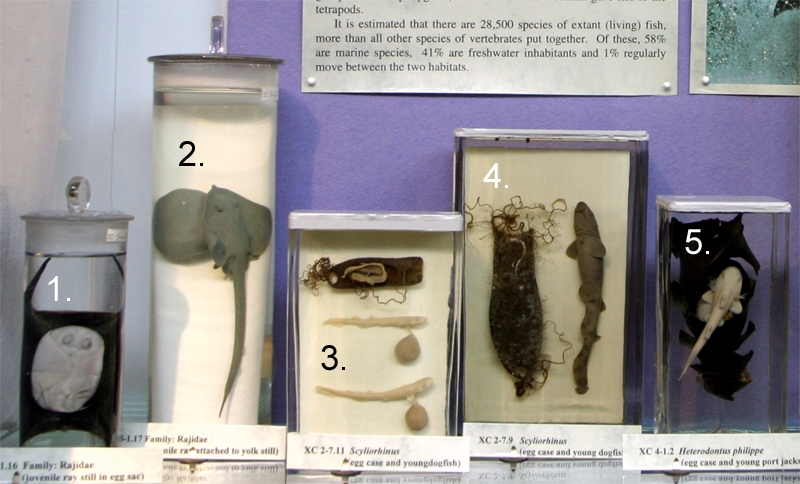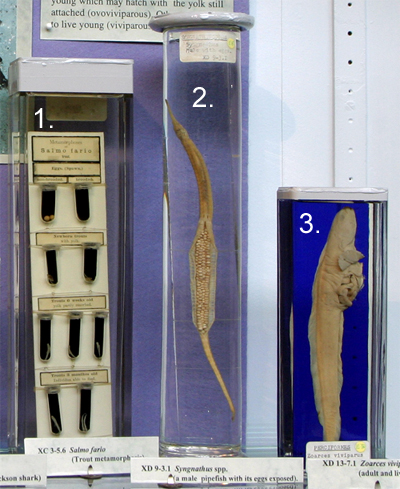
FISH REPRODUCTIVE STRATEGIES
CARTILAGINOUS FISH
Cartilaginous fish usually expend most of their reproductive energies in producing relatively few eggs and a small number of young which may take up to 15 months to develop into miniature adults with a high survival rate. Many (43% ) known sharks and rays lay egg sacs in which the embryos develop into large, active young that may hatch with the yolk still attached. In other species, the female retains her eggs until the young are ready to hatch. The females of most known species (57%) bear live young. The embryos are nourished in the uterus of the female, who gives birth to few relatively large, live young.

1. Juvenile skate (Family Rajidae, rays) still in egg case. The embryo’s fins are folded to fit into the case.
2. Juvenile skate (Family Rajidae, rays ). Young skate attached to yolk sac.
3. Embryos of Scyliorhinus sp. possibly stellaris, the nursehound, (Family Scyliorhinidae, cat sharks). The embryos already show the typical ‘shark’ shape of the adult.
4. Egg case, a mermaid’s purse, and embryo of Scyliorhinus sp. possibly stellaris. The tendrils of the egg case hold the egg in sea-weed. The presence of colonies of epiphytic invertebrates on the case show the prolonged period needed for the embryos to grow and hatch.
5. Spiral egg case and embryo of Heterodontus francisci, the horn shark (Family Heterodontidae). The typical spiral shape of the egg case makes it very difficult to remove from the rocky crevices into which the female horn sharks wedges her eggs. Possibly the only example of parental care expressed by sharks! A small adult of the related species, Heterodontus portjacksonus, is displayed with the sharks. Both sharks, even as embryos, have characteristic spines in front of both dorsal fins.
BONY FISH
Most bony fish are oviparous and lay eggs like Salmo trutta, the brown trout (Family Salmonidae). The female releases thousand of minute eggs into the water where they are fertilized externally by sperm produced by the male and develop into small fish. The reproductive strategy of small egg/high fecundity is well illustrated by the capacity of a six year old female cod (Gadus morhua) to produce five million eggs to offset the dangers faced by her offspring as they try to grow, mature and reproduce in their turn.
The birth of live young, is virtually unknown in bony fishes. So Zoarces viviparus, the North Atlantic eelpout (Family Zoarcidae), is very unusual in that the female gives birth to fully formed young.
Parental care is rare in fishes but occurs in pipe fishes and sea horses (Family Syngnathidae). In this family, the females place their eggs in the male’s pouch. The males brood the eggs until the young hatch and can swim actively when he expels them into the water.

1. Development of Salmo trutta.
2. Male pipe fish, Syngnathus sp., brooding eggs in brood pouch.
3. Dissection of female Zoarces vivparus shows fish-shaped young in uterus.






